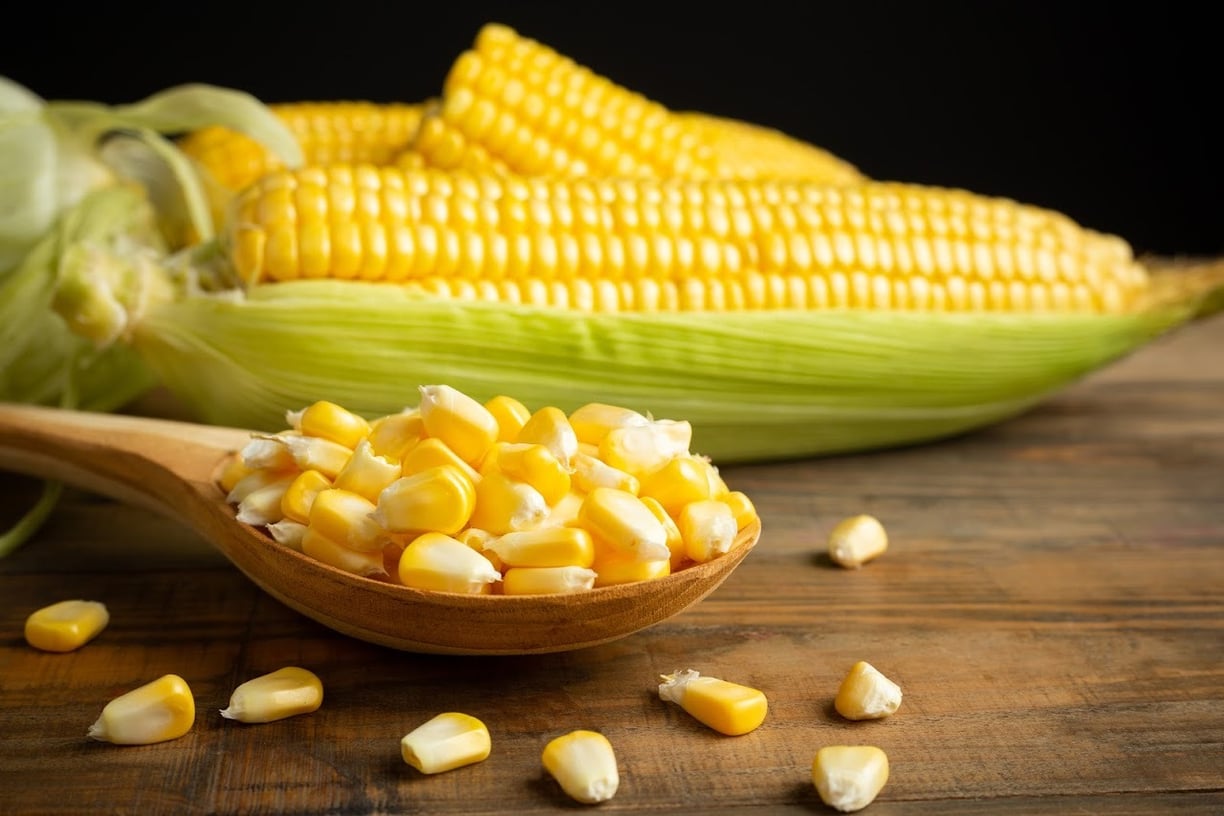Corn
Sweet corn is loaded with lutein & zeaxanthin, two phytochemicals that promote healthy vision. Besides helping with weight loss, the insoluble fiber in corn feeds good bacteria in your gut, which aids in digestion & helps keep you regular. Throw in a healthy amount of B vitamins, plus iron, protein, & potassium, & you've...
HEALTHY & FUN FRUITY FACTS


Corn
Sweet corn is loaded with lutein and zeaxanthin, two phytochemicals that promote healthy vision. Besides helping with weight loss, the insoluble fiber in corn feeds good bacteria in your gut, which aids in digestion and helps keep you regular. Throw in a healthy amount of B vitamins, plus iron, protein and potassium, and you've got one sweet package.
Cooking sweet corn actually boosts its benefits. In a Cornell study, researchers found that while sweet corn loses vitamin C during cooking, its antioxidant activity increases. Studies show eating foods high in antioxidants can help lower your risk of heart disease as well as Alzheimer's disease, cataracts and other health problems linked to aging. Cooked sweet corn also has a surprising amount of ferulic acid, a type of compound that helps fight cancer.
Nutrition facts
Here are the nutrition facts for 3.5 ounces (100 grams) of boiled yellow corn:
-Calories: 96
-Water: 73%
-Protein: 3.4 grams
-Carbs: 21 grams
-Sugar: 4.5 grams
-Fiber: 2.4 grams
-Fat: 1.5 grams
-Carbs
Like all cereal grains, corn is primarily composed of carbs. Starch is its main carb, comprising 28–80% of its dry weight. Corn also provides small amounts of sugar (1–3%).
Sweet corn, or sugar corn, is a special, low-starch variety with higher sugar content, at 18% of the dry weight. Most of the sugar is sucrose. Despite the sugar in sweet corn, it is not a high-glycemic food, ranking low or medium on the glycemic index (GI).
Fiber
Corn contains a fair amount of fiber. One medium bag (112 grams) of cinema popcorn boasts approximately 16 grams of fiber. This is 42% and 64% of the Daily Value (DV) for men and women, respectively. While the fiber content of different types of corn varies, it’s generally around 9–15% of the dry weight. The predominant fibers in corn are insoluble ones, such as hemicellulose, cellulose, and lignin.
Protein
Corn is a decent source of protein. Depending on the variety, the protein content ranges from 10–15%. The most abundant proteins in corn are known as zeins, accounting for 44–79% of the total protein content. Overall, the protein quality of zeins is poor because they lack some essential amino acids. Zeins have many industrial applications, as they’re used in the production of adhesives, inks, and coatings for pills, candy, and nuts.
Vitamins and minerals
Corn may contain a fair amount of several vitamins and minerals. Notably, the amount is highly variable depending on the corn type. In general, popcorn is rich in minerals, whereas sweet corn is higher in many vitamins.
-Pantothenic acid. Also called vitamin B5, this acid is found to some extent in nearly all foods. Thus, deficiency is rare.
-Folate. Also known as vitamin B9 or folic acid, folate is an essential nutrient, especially important during pregnancy.
-Vitamin B6. B6 is a class of related vitamins, the most common of which is pyridoxine. It serves various functions in your body.
-Niacin. Also called vitamin B3, niacin in corn is not well absorbed. Cooking corn with lime can make this nutrient more available for absorption.
-Potassium. An essential nutrient, potassium is important for blood pressure control and may improve heart health.
-Other plant compounds
Corn contains a number of bioactive plant compounds, some of which may boost your health. In fact, corn boasts higher amounts of antioxidants than many other common cereal grains:
-Ferulic acid. This is one of the main polyphenol antioxidants in corn, which contains higher amounts of it than other cereal grains like wheat, oats, and rice.
-Anthocyanins. This family of antioxidant pigments is responsible for the color of blue, purple, and red corn.
-Zeaxanthin. Named after corn’s scientific name (Zea mays), zeaxanthin is one of the most common plant carotenoids. In humans, it has been linked to improved eye health.
-Lutein. One of the main carotenoids in corn, lutein serves as an antioxidant, protecting your eyes from oxidative damage produced by blue light.
-Phytic acid. This antioxidant may impair your absorption of dietary minerals, such as zinc and iron.
Health benefits
Regular whole-grain intake may have a number of health benefits. As a good source of lutein and zeaxanthin, corn may help maintain your eye health. What’s more, it doesn’t promote diverticular disease, as previously thought. On the contrary, it seems to be protective.
Eye health
Macular degeneration and cataracts are among the world’s most common visual impairments and major causes of blindness. Infections and old age are among the main causes of these diseases, but nutrition may also play a significant role. Dietary intake of antioxidants, most notably carotenoids like zeaxanthin and lutein, may boost eye health. Lutein and zeaxanthin are the predominant carotenoids in corn, accounting for approximately 70% of the total carotenoid content. However, their levels are generally low in white corn. Commonly known as macular pigments, these compounds exist in your retina, the light-sensitive inner surface of your eye, where they protect against oxidative damage caused by blue light. High levels of these carotenoids in your blood are strongly linked to a reduced risk of both macular degeneration and cataracts.
Observational studies likewise suggest that high dietary intake of lutein and zeaxanthin may be protective, but not all studies support this.
One study in 356 middle-aged and older adults found a 43% reduction in the risk of macular degeneration in those with the highest intake of carotenoids, especially lutein and zeaxanthin, compared to those with the lowest intake.
